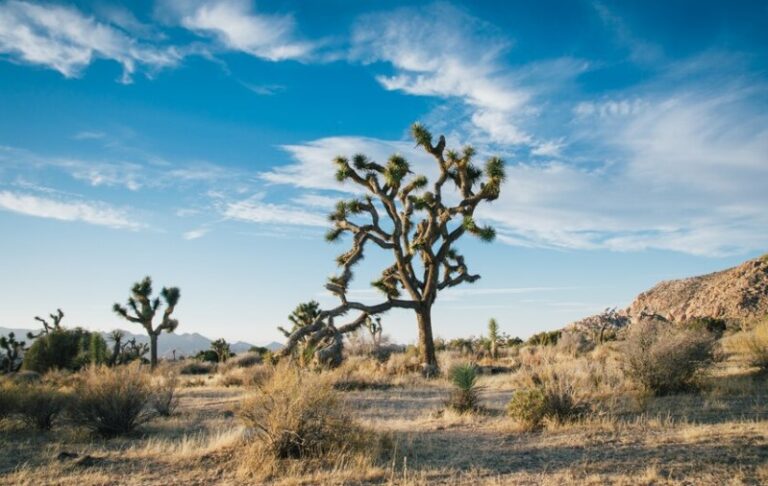Nestled in southeastern California, Joshua Tree National Park is a captivating desert landscape renowned for its majestic Joshua trees, awe-inspiring rock formations, and unparalleled stargazing opportunities. With its diverse ecosystems and abundance of recreational activities, the park offers unforgettable experiences throughout the year. If you’re planning a trip to Joshua Tree National Park in 2024, here are 10 optimal times to visit:
1. Spring (March-May)
Spring brings a vibrant burst of color to the park as wildflowers bloom in abundance, creating a breathtaking tapestry across the desert floor. The weather is pleasant, with daytime temperatures typically ranging from 70-85°F, making it ideal for hiking, biking, and rock climbing.
Special events during this time include the Joshua Tree Music Festival and the Joshua Tree National Park Arts Festival, showcasing the region’s vibrant arts scene.
2. Autumn (October-November)
Autumn in Joshua Tree National Park is a season of transition, marked by cooler temperatures and stunning foliage. The Joshua trees turn a vibrant golden hue, contrasting beautifully with the deep blue skies. Hiking and horseback riding are excellent ways to experience the park’s beauty during this time.
In October, the park hosts the Desert Institute’s Annual Symposium, offering educational programs on the unique ecology and history of the area.
3. Winter (December-February)
While winter temperatures can drop below freezing at night, daytime temperatures remain mild, making it a great time to explore the park without the summer crowds. The crisp, clear skies provide exceptional stargazing opportunities, with the Milky Way visible on most nights.
Joshua Tree also offers winter camping, albeit with limited amenities. Make sure to pack warm clothing and a sleeping bag rated for cold weather.
4. Days After Rain
After a rainfall, the desert comes alive with vibrant blooms. The creosote bushes burst into a bright yellow hue, while the ocotillos sport vibrant red flowers. The air is filled with the sweet scent of wildflowers, creating an unforgettable sensory experience.
Keep an eye on the weather forecast and plan your visit after a moderate rainfall for the best floral displays.
5. Full Moon Nights
The full moon casts an ethereal glow over Joshua Tree National Park, illuminating the towering rock formations and creating a magical atmosphere.
The park offers full moon hikes and stargazing events, providing an opportunity to experience the park’s beauty under the lunar light.
6. New Moon Nights
Coinciding with the new moon, the darkest nights of the month offer exceptional stargazing opportunities. The lack of artificial light pollution makes it easier to observe the Milky Way and countless stars.
Bring a telescope or join a guided astronomy tour to enhance your celestial exploration.
7. Meteor Showers
Joshua Tree National Park is an ideal location for meteor shower viewing due to its remote location and clear skies. The annual Perseid meteor shower in August and the Geminid meteor shower in December offer the best chances to witness a celestial light show.
Find a secluded spot away from park lights and lie back on a blanket to enjoy the breathtaking display.
8. Memorial Day Weekend
Memorial Day weekend marks the unofficial start of summer and is a popular time to visit Joshua Tree National Park. While temperatures can be warm during the day, nighttime lows are often comfortable for camping.
The park hosts ranger-led programs and special events over the weekend, making it a great time to connect with nature and learn about the park’s history.
9. Labor Day Weekend
Labor Day weekend offers a last chance to enjoy the park before the summer crowds subside. The weather is still warm and sunny, but the nights start to cool down, making it ideal for camping and stargazing.
The park also hosts guided hikes and educational programs during this weekend, providing a perfect opportunity to explore the park’s diverse ecosystems.
10. Anytime
Joshua Tree National Park is a year-round destination, offering unique experiences throughout the seasons. Whether you seek solace in the desert solitude, marvel at the celestial wonders, or simply immerse yourself in the park’s natural beauty, there is always a perfect time to visit.
Culture
Joshua Tree National Park is steeped in a rich cultural heritage. The area has been inhabited by Native American tribes for centuries, and their influence can be seen in the park’s rock art and petroglyphs. The park also played a significant role in the counterculture movement of the 1960s and 1970s, and its legacy can still be felt in the vibrant arts community that surrounds the park.
Nearby Transportation
Joshua Tree National Park is easily accessible by car. The nearest major airport is Palm Springs International Airport (PSP), located about 45 miles west of the park. Alternatively, you can fly into Ontario International Airport (ONT) or Los Angeles International Airport (LAX) and rent a car to drive to the park.
Public Transportation
Public transportation to Joshua Tree National Park is limited. The nearest bus stop is located in the town of Joshua Tree, about 10 miles from the park entrance. From there, you can take a taxi or ride-sharing service to the park.
Accommodation Options
There are a variety of accommodation options available near Joshua Tree National Park, ranging from campgrounds to luxury resorts. The park itself offers several campgrounds with varying levels of amenities. If you prefer a more traditional lodging experience, there are several hotels and motels in the nearby towns of Joshua Tree and Twentynine Palms.
For a truly unique experience, consider staying in a yurt or cabin at one of the park’s concessionaires. These accommodations offer a comfortable and immersive way to connect with the desert environment.
No matter what time of year you visit, Joshua Tree National Park offers an unforgettable adventure filled with natural wonders and cultural richness. Embrace the beauty of the desert and create memories that will last a lifetime.
